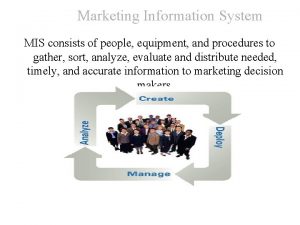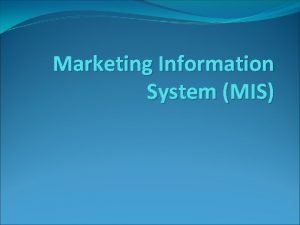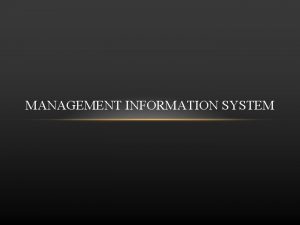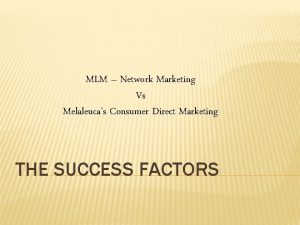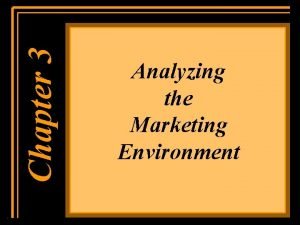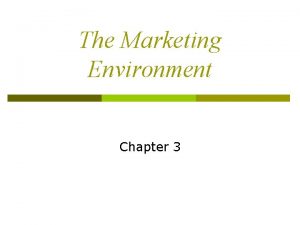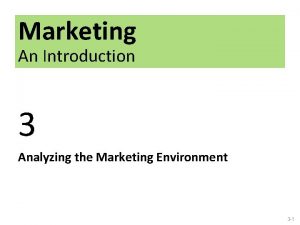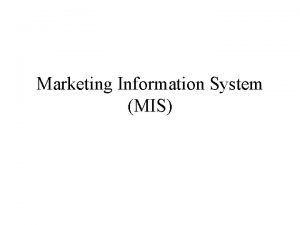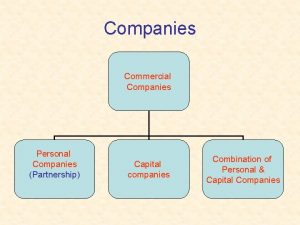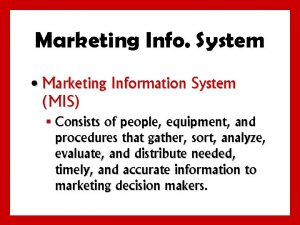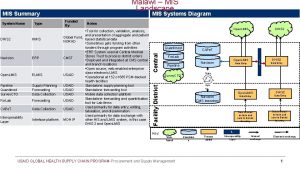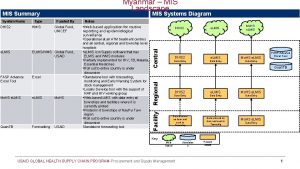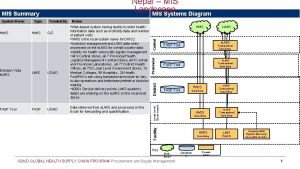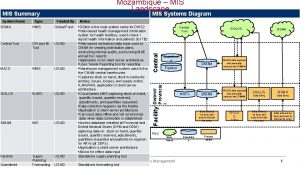Marketing Information System MIS Companies need sound information












- Slides: 12

Marketing Information System (MIS) • Companies need sound information to produce superior value and satisfaction for its customers. • Companies also require information on competitors, resellers, and other actors and forces in the marketplace. • Marketers are increasingly viewing information as an important strategic asset and marketing tool. 1

Customer Insights • To create value for customers and build meaningful relationships with them, marketers must first gain fresh, deep insights into what customers need and want • Such customer insights come from good marketing information. • To gain good customer insights, marketers must effectively manage marketing information from a wide range of sources such as traditional marketing research studies, mingling with and observing consumers and even monitoring consumer online conversations about the company and its products. 2

Marketing Information System (MIS) • MIS consists of people, equipment and procedures dedicated to assessing information needs, developing the needed information and sharing it with decision makers. • MIS helps users to analyse and use the information to develop customer insights, make marketing decisions, and manage customer relationships. • The MIS must monitor the marketing environment to provide decision makers with information they should have to better understand customers and make key marketing decisions. 3

MIS Structure Developing Needed Information Assessing Information Needs • Internal databases • Marketing Intelligence • Marketing Research Analysing and Using Information 4

Assessing information needs • Who needs the information • What kind of information is needed • Where and how can the information be obtained • At what cost 5

Developing MI: sources • Internal Data bases • Marketing Intelligence • Marketing Research 6

Internal Data Bases • Collection of electronic information obtained from data sources within the company • Sources of internal data includes records of sales, costs, production schedules, shipments etc • Internal databases usually can be accessed more quickly and cheaply than other information sources. • Disadvantages are: information may be incomplete or in wrong form for making marketing decisions • Data also ages quickly, therefore updating the database could require major effort. • Managing large amounts of information may require highly sophisticated equipment and techniques. 7

Marketing intelligence • Systematic collection and analysis of publicly available information about consumers, competitors and developments in the marketplace. • Main objective is to improve strategic decision making, assess and track competition and provide early warnings of opportunities and threats. • The techniques range from observing consumer first hand to quizzing the company’s employees, benchmarking with competitors, researching the internet and monitoring internet buzz. 8

Marketing Research • Systematic design, collection, analysis and reporting of data relevant to a specific marketing situation facing an organization. • It is used to assess market potential, market share; customer motivations, behaviours, satisfaction etc • Can also be used to measure effectiveness of pricing, product, distribution and promotion activities. 9

The Marketing Research Process • 1. Defining the problem and research objectives • 2. Developing the research plan for collecting data • 3. Implementing the research plancollecting and analysing data • 4. Interpreting and reporting the findings 10

Marketing Research • The research may be exploratory, descriptive or causal • Both internal and external secondary sources often provide information more quickly and cheaply than primary sources • Primary data collection methods- observation, survey, experiments • Research instruments- questionnaires, interviews, mechanical instruments 11

Analysing and using Marketing Information • Information gathered databases, marketing intelligence and marketing research usually requires more analysis. • Hence the need for special software and analysis techniques e. g. Customer Relationship Management 12
 What is marketing information system
What is marketing information system Marketing information system meaning
Marketing information system meaning Introduction of management information system
Introduction of management information system Marketing information systems and marketing research
Marketing information systems and marketing research Amway vs melaleuca
Amway vs melaleuca Analyzing the market environment
Analyzing the market environment Responding to the marketing environment
Responding to the marketing environment Companies who passively accept the marketing environment
Companies who passively accept the marketing environment Para mi proyecto de vida yo deshecho
Para mi proyecto de vida yo deshecho El sobrino de mi madre es mi ____
El sobrino de mi madre es mi ____ Mis mai a mis tachwedd
Mis mai a mis tachwedd Mis mai a mis tachwedd
Mis mai a mis tachwedd Cuales son mis creencias
Cuales son mis creencias
